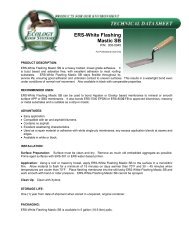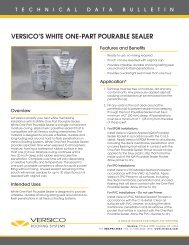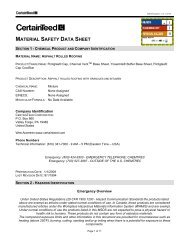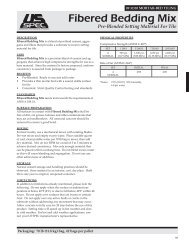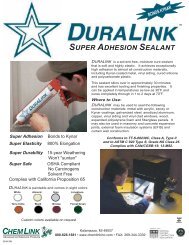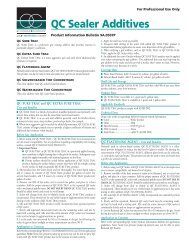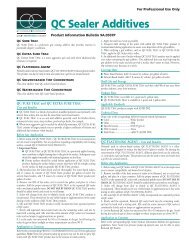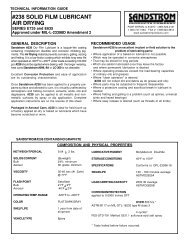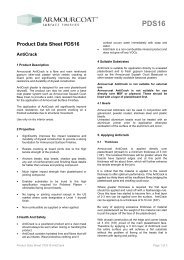Simpson Anchors - Anchoring and Fastening Systems - BuildSite.com
Simpson Anchors - Anchoring and Fastening Systems - BuildSite.com
Simpson Anchors - Anchoring and Fastening Systems - BuildSite.com
Create successful ePaper yourself
Turn your PDF publications into a flip-book with our unique Google optimized e-Paper software.
Crack Injection<br />
108<br />
CRACK-PAC ®<br />
Injection Procedure for Crack-Pac ® Flex-H 2 0 crack sealer<br />
1. Follow cartridge preparation instructions on the cartridge label. Verify<br />
that the material fl owing from the nozzle is a uniform green color.<br />
2. Attach the E-Z-Click fi tting to the end of the nozzle by pushing the<br />
tubing over the barbs at the end of the nozzle. Make sure that all ports<br />
are pushed in to the open position.<br />
3. Attach the E-Z-Click injection fi tting to the<br />
fi rst E-Z-Click port until it clicks into place.<br />
Make sure that the head of the port is<br />
pushed in to the open position. In vertical<br />
applications, begin injection at the lowest<br />
port <strong>and</strong> work your way up. In a horizontal<br />
application start at one end of the crack<br />
<strong>and</strong> work your way to the other end.<br />
4. Inject polyurethane into the fi rst port until<br />
material shows at the next port. Remove<br />
the E-Z-Click fi tting by bracing the base<br />
of the port <strong>and</strong> pulling out gently on the<br />
head of the port to close it. Pulling too<br />
hard may dislodge the port from the<br />
surface of the concrete, causing a leak.<br />
Depress the metal tab on the head of<br />
the E-Z-Click fi tting <strong>and</strong> remove it from<br />
the port.<br />
5. Move to the next port <strong>and</strong> repeat until<br />
all ports have been injected.<br />
Troubleshooting<br />
FLEX-H2O Injection Guide<br />
Polyurethane is fl owing into the crack, but not showing up<br />
at the next port.<br />
This can indicate that either the crack exp<strong>and</strong>s <strong>and</strong>/or branches off<br />
under the surface of the concrete. Continue to inject <strong>and</strong> fi ll these voids.<br />
Back pressure is preventing polyurethane from fl owing.<br />
This can indicate several situations:<br />
• The crack is not continuous <strong>and</strong> the portion<br />
being injected is full.<br />
• The port is not aligned over the crack properly.<br />
• The crack is blocked by debris.<br />
Polyurethane is leaking from the pasted-over crack<br />
or around injection ports.<br />
Stop injecting. If using a fast cure paste-over material (ETR or CIP),<br />
wipe off the leaking injection epoxy with a cotton cloth <strong>and</strong> re-apply the<br />
paste over material. Wait a approximately 10–15 minutes to allow the<br />
paste-over to begin to harden. If the leak is large (e.g. the port broke<br />
off of the concrete surface) it is a good idea to wait approximately<br />
30 minutes, or longer as necessary, to allow the paste-over to cure<br />
more <strong>com</strong>pletely. Check to see that the paste-over is hard before<br />
reinjecting or the paste-over or ports may leak.<br />
Another option for small leaks is to clean off the injection adhesive<br />
<strong>and</strong> use paraffi n or crayon to seal the holes.<br />
3<br />
4<br />
Injection Tips<br />
• For narrow cracks it may be necessary to increase the pressure<br />
gradually until the polyurethane begins to fl ow. It may also be<br />
necessary to wait a few minutes for the material to fi ll the crack<br />
<strong>and</strong> travel to the next port.<br />
• If desired, once the polyurethane has cured, remove the injection<br />
ports <strong>and</strong> paste-over epoxy or hydraulic cement. The paste-over<br />
can be removed with a chisel, scraper or grinder.<br />
More polyurethane is being used than estimated.<br />
This may indicate that the crack either exp<strong>and</strong>s or branches off below<br />
the surface. Continue to inject <strong>and</strong> fi ll these voids.<br />
Less polyurethane is being used than estimated.<br />
This may indicate that the crack is shallower than originally thought,<br />
or the polyurethane is not penetrating the crack suffi ciently before<br />
moving to the next port.<br />
C-SAS-2009 © 2009 SIMPSON STRONG-TIE COMPANY INC.



